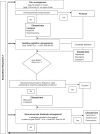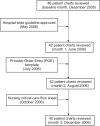Implementation of a guideline for the treatment of pain, sedation, agitation and neuromuscular blockade in the mechanically ventilated adult patient in the emergency department
- PMID: 27147848
- PMCID: PMC4753963
- DOI: 10.2147/OAEM.S17042
Implementation of a guideline for the treatment of pain, sedation, agitation and neuromuscular blockade in the mechanically ventilated adult patient in the emergency department
Abstract
Purpose: When emergency department (ED) overcrowding includes admitted mechanically ventilated (MV) critically-ill patients without an open intensive care unit (ICU) bed, emergency providers must deliver ICU level care in the ED. Implementing standardized hospital based clinical guidelines may help providers achieve uniform care standards for assessing and managing pain and sedation for the MV patient.
Objective: This paper is a description of a hospital performance improvement project that was implemented in the ED. The objective of this study was to measure the degree of adoption of a hospital-wide clinical guideline for the management of pain, sedation and neuromuscular blockade in MV patients into clinical practice in the ED.
Methods: A retrospective analysis was performed for all mechanically ventilated patients who were admitted from ED to an Intensive Care Unit (ICU). Patient charts were reviewed before (December 2005) and after the implementation of the guideline (June, August, and December 2006). Data was collected and analyzed for the ED visit only and no ICU data was used. The primary outcome was the degree of adoption of the guideline by emergency providers into their daily clinical practice.
Results: A convenience sample of 170 adult MV patients who were admitted to the ICU during the preselected time period was analyzed. There were no demographic differences between groups of patients observed during each month interval, age (P = 0.34), gender (P = 0.40), race (P = 0.14), and Hispanic ethnicity (P = 0.84). Overall, there was an increase in the provider use of propofol (P < 0.01), RASS sedation scale (P < 0.01), and a decrease in the use of a paralytic agent (P < 0.01).
Conclusion: There was partial adoption of a guideline into their clinical practice by emergency providers in a busy urban emergency department. Across the 12-month implementation period, there was improvement in the assessment of and use of analgesia and sedation for MV patients.
Keywords: ICU; clinical guideline; critical care; emergency department; neuromuscular blocker; pain; sedation.
Figures


Similar articles
-
Pain, Agitation, and Delirium Guidelines: Interprofessional Perspectives to Translate the Evidence.Dimens Crit Care Nurs. 2017 May/Jun;36(3):164-173. doi: 10.1097/DCC.0000000000000239. Dimens Crit Care Nurs. 2017. PMID: 28375992
-
Evaluation of a local ICU sedation guideline on goal-directed administration of sedatives and analgesics.J Pain Res. 2011;4:127-34. doi: 10.2147/JPR.S18161. Epub 2011 May 2. J Pain Res. 2011. PMID: 21647216 Free PMC article.
-
Evaluation of Richmond Agitation Sedation Scale (RASS) in Mechanically Ventilated in the Emergency Department.Adv Emerg Nurs J. 2018 Apr/Jun;40(2):131-137. doi: 10.1097/TME.0000000000000184. Adv Emerg Nurs J. 2018. PMID: 29715257
-
The methodological approach used to develop the 2013 Pain, Agitation, and Delirium Clinical Practice Guidelines for adult ICU patients.Crit Care Med. 2013 Sep;41(9 Suppl 1):S1-15. doi: 10.1097/CCM.0b013e3182a167d7. Crit Care Med. 2013. PMID: 23989088 Review.
-
Managing sedation in the mechanically ventilated emergency department patient: a clinical review.J Am Coll Emerg Physicians Open. 2020 Apr 10;1(3):263-269. doi: 10.1002/emp2.12045. eCollection 2020 Jun. J Am Coll Emerg Physicians Open. 2020. PMID: 33000041 Free PMC article. Review.
References
-
- Kress JP, Pohlman AS, O’Connor MF, Hall JB. Daily interruption of sedative infusions in critically ill patients undergoing mechanical ventilation. N Engl J Med. 2000;342(20):1471–1477. - PubMed
-
- Wittbrodt ET. Daily interruption of continuous sedation. Pharmacotherapy. 2005;25(5 Pt 2):3S–7S. - PubMed
-
- Chalfin DB, Trzeciak S, Likourezos A, Baumann BM, Dellinger RP, DELAY-ED study group Impact of delayed transfer of critically ill patients from the emergency department to the intensive care unit. Crit Care Med. 2007;35(6):1477–1483. - PubMed
-
- Jacobi J, Fraser GL, Coursin DB, et al. Clinical practice guidelines for the sustained use of sedatives and analgesics in the critically ill adult. Crit Care Med. 2002;30(1):119–141. - PubMed
LinkOut - more resources
Full Text Sources

